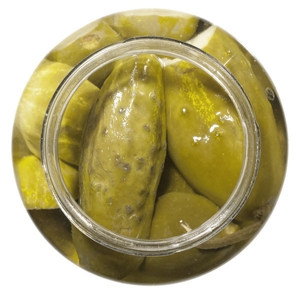Remember, every summer, when your Mom (or Grandma) made Pickles? What do you remember best? Dills? Bread and Butter? Green Tomato Pickles? Sweet Chili Sauce? Chow-Chow? They’re all classics and I’ve got the original recipes from my Mom’s High School Cook Book!
 Home made garlic Dills in 1 qt. / 1 L standards preserving jars. Note the addition
Home made garlic Dills in 1 qt. / 1 L standards preserving jars. Note the addition
of Dill Fronds and whole Garlic cloves to each jar.
Page 49 in the 1937 edition of Theory and Practice in Household Science covers what were – and for many, still are – the basic varieties of Pickles. As with many recipe selections designed by and for folks with Western European and British heritage, these have many ingredients and techniques in common. But each has its own unique flavour and texture.
The Pickle Principle
Pickling was originally embraced by gardeners who wanted to preserve their Summer bounty for Veggies and Fruits to which the technique is traditionally applied. They added spices and Seasonings to help make the resulting sour product more palatable. Regional and family choices of Flavourings eventually became the basis of recipes that have been handed down over many generations.
Vinegar
Good old White Vinegar – the same stuff you’d get in the shaker at the Fish and Chips Shop and which your Mom probably washed the windows every Spring, is the key to Heritage Pickles. Since Wine Vinegars became more popular and more available, some boutique Picklers have started using them and I have even seen a Rosé Sweet Pepper Pickle at a local food boutique.
Seasonings
Salt and Pepper are always used in Pickling Spice mixes. hey perform the same function in Pickles that they do in other dishes – prepare your mouth to taste more ff the flavour in the food. But Salt is also a champion preserver, and much more Salt is typically used in Pickling brines than in other recipes. Pepper is generally added as Whole Black Peppercorns.
I’m also going to include Sugar in this category. There’s always a fairly large amount of Sugar in Pickles, to offset the harshness of the large amounts of Salt and Vinegar that are always present.
Spices and Flavours
Whole Cloves are often included in Old School Pickle recipes. They provide a nice deep, rich almost sweet flavour.
Cinnamon is often included in Pickling mixes. Goes well with the Cloves and adds a little spicy edge.
Whole Mustard Seed is also a favourite, providing that Mustard zing. A nice counterpoint to the Cinnamon and Coves!
Mustard – Prepared or in Powder form – is used in Bread and Butter Pickles as well as your standard Mustard Pickle, which typically features String Beans and/or Cauliflower and/or Cucumbers.
Dill Pickles require Dill Fronds. Dill is the key flavour there, often complemented with varying amounts of Garlic. Neither Garlic nor Dill was easily avail;able to the folks who farmed the Prairies back in the 30s, so Mom’s Cook Book doesn’t make much mention of them.
Bay Leaf is a great addition – and a standard ingredient of any premixed Pickling Spice blend you’ll fins at the store. But it was absent from the recipes in Mom’s day. Like Dill and Garlic, it was not part of the Prairie Pantry.
Other ingredients are found in the flavouring mixtures for specific kinds of Pickles, but those are largely more modern Pickles, many created by the Packaged Food Industry and the Boutique Food sector and many of those adapted from older, simpler recipes.
The Basic Technique
Most standard Pickle recipes start by mixing Sugar, Salt and Vinegar and differeing amounts of Water in a large kettle and bringing that trio to a boil. Next, Seasonings and Spices are added and the augmented mixture cooks for a while to release the flavours and ensure that the Salt and Sugar are completely dissolved. That’s your basic Pickling Brine.
At this point, any Veggies that are too hard to soften through Pickling alone (String Beans, Cauliflower, Corn Kernels, etc.) are added to par-cook. You want them tender-crisp; scalded is the Chef’s term. For softer Veggies such as Cucumbers, you just wash them, cut them in whatever shape you want and pack them into to the Pickle jar where they will rest and soak up the Pickling brine. Jars and lids must be sterilized with boiling water before filling. Fill them right away, while they’re still hot, and screw put the lids on right away, just to finger tight.
Let the jars cool to room temperature. A vacuum seal will form under the lid. Store for up to 6 months in a cool, dark place.
In future posts, we’ll start making some Heritage Pickles and see how they stack up against their modern day counterparts!
~ Maggie J.

